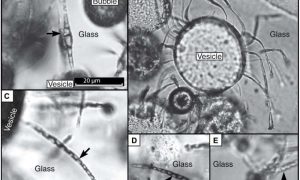
Tubular microtunnels believed to be the trace fossils formed by microbes inhabiting volcanic rock interiors have only been reported in oceanic and subglacial settings. This is the first observation of such features in basaltic volcanic glass erupted in a continental lake environment, the Fort Rock volcanic field.
As a result, the record of subsurface microbial activity in the form of endolithic microborings is prospectively expanded. Our understanding of the range of environments and conditions that microtunnels can form in is enhanced along with our knowledge of potentially habitable environments on Earth and beyond.
The Fort Rock volcanic field has analogous characteristics to locations found on Mars such as Gale and Gusev crater. The presence of these features in this new geologic setting may suggest that subsurface microbes or evidence thereof, if present on Mars, could exist nearer to the surface than previously thought. This knowledge can thus aid future Mars missions (e.g., Mars 2020 Project) with goals that include searching out biosignatures and finding suitable rocks for sample return.
Reference:
Candidate microbial ichnofossils in continental basaltic tuffs of central Oregon, USA: Expanding the record of endolithic microborings, M.P.C. Nikitczuk et al., Department of Earth Sciences, Brock University, 1812 Sir Isaac Brock Way, St. Catharines, Ontario L2S 3A1, Canada. This article is Open Access online at http://gsabulletin.gsapubs.org/content/early/2016/04/20/B31380.1.abstract.
Note: The above post is reprinted from materials provided by Geological Society of America.










